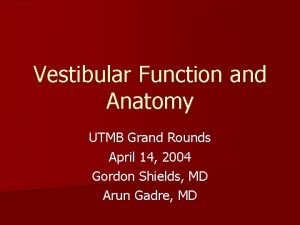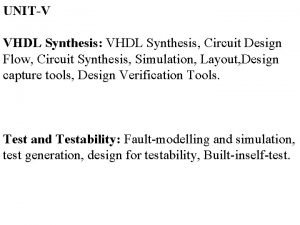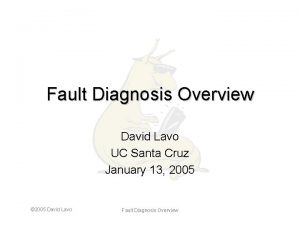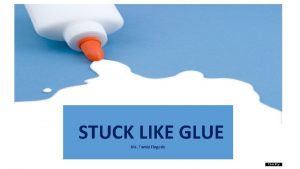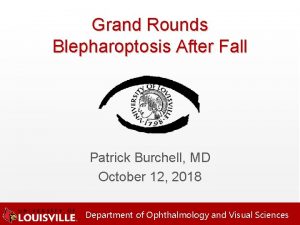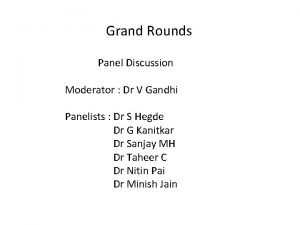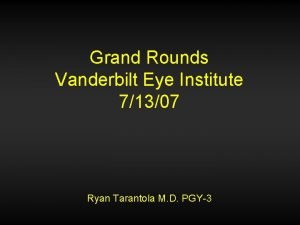Grand Rounds Stuck in the wrong place Patrick























- Slides: 23

Grand Rounds Stuck in the wrong place Patrick Burchell, PGY-2 June 15, 2016 Department of Ophthalmology and Visual Sciences

Patient Presentation CC: Sudden vision loss OD HPI: 66 yo WM with a complex traumatic dural arteriovenous fistula status post prior motor vehicle accident, who underwent repeat embolization with Onyx. Ophthalmology was paged to the PACU for sudden vision loss of the right eye upon awakening.

What is Onyx? • Non-adhesive liquid embolic agent – Ethylene vinyl alcohol (EVOH) – Dimethyl sulfoxide (DMSO) – Tantalum powder • Solidifies from outside to inside – 5 minutes • Prolonged injection times compared to Nbutyl cyanoacrylate glue

History (Hx) Past Ocular Hx: – Nuclear Sclerosis OU Past Medical Hx: – Traumatic dural arteriovenous malformation (DAVF), carotid stenosis, hyperlipidemia, hypertension, GERD, seasonal allergies Past Surgical Hx: – Embolization of DAVF X 3, exploratory laparotomy, left knee repair, right maxilla repair

History (Hx) Fam Hx: – Aneurysm (sister) Meds: – Amlodipine-benzapril 10 mg, Aspirin 325 mg, Pantoprazole 40 mg, Rosuvastatin 20 mg Allergies: – NKDA Social Hx: – Previous smoker (35 pack years) ROS: – + decreased vision OD; denied pain, flashes, floaters

External Exam OD OS VA (N sc) Light Perception Pupils 5→ 4 mm (sluggish) IOP 14 mm. Hg 15 mm. Hg EOM full CVF 20/70 3+ RAPD OD 4→ 3 mm full

Anterior Segment Exam PLE OD OS External/Lids WNL Conj/Sclera WNL Cornea Clear Ant Chamber Formed Iris WNL Lens Nuclear Sclerosis

Posterior Segment Exam Fundus OD OS Optic Nerve Pallor Pink and sharp Macula Cherry red spot, with retinal whitening in the posterior pole WNL Vessels Arteries attenuated WNL Periphery WNL

Cerebral Angiography Onyx Ophthalmic Artery Sagittal view of Left Internal Carotid Artery (LICA) Sagittal view of Right Internal Carotid Artery (RICA); bone window

Cerebral Angiography Choroidal Blush No choroidal Blush Late phase sagittal view of LICA Late phase sagittal view of RICA

Post-operative CT Onyx Axial bone window

Assessment/Plan • 66 yo WM with LP OD and a central retinal artery occlusion status post embolization of a DAVF with Onyx. • Plan – No intervention due to the nature of the occlusion – No reversal agent available for Onyx – Follow up in Retina Clinic

1 week follow up OD OS

SD-OCT

Central Retinal Artery Occlusion • Epidemiology – 1. 9 per 100, 000 people • Risk Factors – – – Male (1. 5 X) Increased age Hypertension Diabetes Carotid artery disease Smoking

Presentation • Sudden, painless loss of vision, 1 eye • Afferent pupillary defect • Fundus appearance – Retinal whitening – Cherry red spot – Arterial attenuation – Hollenhorst plaques • Irreversible damage begins after 97 minutes in primate model 5

Causes and Treatment • Most often due to embolization or thrombosis at the lamina cribosa – 5% due to vasculitic cause like Giant Cell Arteritis • 66 -80% will have final VA 20/400 or worse • No treatments currently with good evidence of efficacy – Intraocular pressure lowering/vasodilation – Thrombolysis

• Retrospective case series of 44 patients • Most common injection site was the Glabella (59%) • Autologous fat was more likely to cause diffuse occlusion (86%) • 27/44 (61%) had final VA of NLP

Glabella https: //plasticsurgerykey. com/glabellar-flaps-in-nasal-reconstruction/

Conclusions • Most often due to embolization, but can also be vasculitic – Evaluate for stroke and other cardiovascular risk factors – Check ESR, CRP, platelets • No great treatments at this time • Botox your glabella, no filler!

Acknowledgements • Dr. Sigford • Dr. Mugavin • Dr. Piri

References 1. 2. 3. 4. 5. 6. Leavitt JA, Larson TA, Hodge DO, Gullerud RE. The incidence of central retinal artery occlusion in Olmsted County, Minnesota. Am J Ophthalmol. 2011 Nov; 152(5): 820 -3. e 2. Mehta N, Marco RD, Goldhardt R, Modi Y. Central Retinal Artery Occlusion: Acute Management and Treatment. Current ophthalmology reports. 2017; 5(2): 149 -159. doi: 10. 1007/s 40135 -017 -0135 -2. Sadeh-Gonike Y, Magand N, Armoiry X, et al. Transarterial Onyx Embolization of Intracranial Dural Fistulas: A Prospective Cohort, Systematic Review, and Meta-Analysis, Neurosurgery, Volume 82, Issue 6, 1 June 2018, Pages 854– 863 Park KH, Kim YK, Woo SJ, et al. Iatrogenic occlusion of the ophthalmic artery after cosmetic facial filler injections: a national survey by the Korean Retina Society. JAMA Ophthalmology. 2014 Jun; 132(6): 714 -23. Hayreh SS, Zimmerman MB, Kimura A, Sanon A. Central retinal artery occlusion. Retinal survival time. Experimental eye research. 2004 March; 78(3): 723 -36 Retina and Vitreous, AAO, BCSC Section 12, 2017 -2018 (132 -135).

• 4 clinical entities 1. 2. 3. 4. Non-arteritic permanent CRAO Amaurosis fugax Non-arteritic with cilioretinal sparing Arteritic CRAO
 Duke medicine grand rounds
Duke medicine grand rounds Nursing grand rounds presentation example
Nursing grand rounds presentation example Utmb grand rounds
Utmb grand rounds Iambic pentameter
Iambic pentameter Kayla adair
Kayla adair Asl the gum story
Asl the gum story President that got stuck in bathtub
President that got stuck in bathtub Melesala khan
Melesala khan Design flow
Design flow Cindy mcdaniel stuck in neutral
Cindy mcdaniel stuck in neutral Defense travel management office
Defense travel management office Dogs season
Dogs season Dts pos ack received
Dts pos ack received Trust star worksheet examples
Trust star worksheet examples It takes two stuck in slide
It takes two stuck in slide Stuck at fault
Stuck at fault Stuck
Stuck El pasado simple de drink
El pasado simple de drink System wersyfikacyjny
System wersyfikacyjny Schwartz rounds facilitator training
Schwartz rounds facilitator training Readiness rounds
Readiness rounds Five layers of neurosis
Five layers of neurosis Sam rounds
Sam rounds 75 to the nearest 10
75 to the nearest 10


